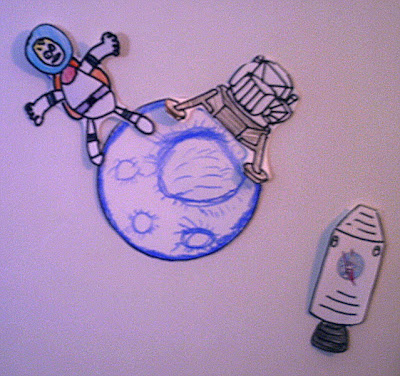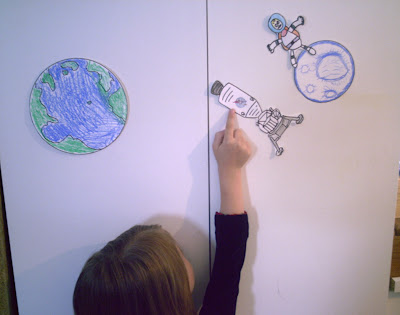
Friday, July 20, 2007
Thursday, July 19, 2007
Lunar Advent
 Sorry for the short entry. Busy drawing rockets and astronauts with my kids. This is our Lunar-Landing Advent Calendar. We're having oatmeal in plastic baggies and Tang for breakfast tomorrow!
Sorry for the short entry. Busy drawing rockets and astronauts with my kids. This is our Lunar-Landing Advent Calendar. We're having oatmeal in plastic baggies and Tang for breakfast tomorrow!
Monday, July 16, 2007
Apollo 11 Launch Anniversary
Today marks the 38th anniversary of the Apollo 11 launch. That mission carried three astronauts, Neil Armstrong, Michael Collins and Edwin 'Buzz' Aldrin to the moon. When Armstrong stepped out onto the Lunar surface, he not only fulfilled the goal set forth by President John F. Kennedy, he realized the work of scientists and researchers stretching back nearly a century, and the dreams of humanity going back to some of our earliest fiction.
I mention this today for two reasons. First, it took the mission four days to get to the Moon and land safely, on July 20th. That gives you a few days to put together a party for this coming Friday, invite some friends, get some rockets to launch, some Tang, and other astronaut food for your guests. The Lunar Landing really deserves celebration.
Second is what the Moon Landing demonstrated. We landed men on the moon on a handful of theories. The Apollo 11 capsule carried them over 200,000 miles through a vacuum to land on the surface of another planetary body with different gravity and no atmosphere to speak of. Then it carried them home again, making the perilous journey through the atmosphere where most objects burn up on entry.
Many people dismiss scientific theories because they define them in the common parlance as little more than opinions or guesses. “Well, it’s just a -theory- anyway.” As used in science, a theory is a logical and mathematical explanation that can be repeatedly demonstrated. The Apollo missions demonstrated that “theories” can be pretty powerful.
Sunday, July 15, 2007
Freefall
One of the roadblocks to human exploration of space is the effect of freefall on our muscles. We can only stand about six months in zero-G before our muscles start to irreversibly jellify. Since Mars and other popular destinations are considerably farther than we can travel in that short a time, NASA is working on the problem with carbon nanotube neural implants. Yep. You read the right.
Now this is a positively delicious idea for even the most casual sci-fi fan. Brain implants to facilitate space travel! It could pioneer all sorts of new technologies. This particular research is directed at transmitting impulses to the brain. But if that research could lead to receiving impulses, then the possibilities really open up. Imagine what a pilot could do if they didn’t have to rely on their physical reflexes to fly an air or space craft? OK, I know, I’ve seen too many movies.
There is another interesting question that rises out of this line of research. Exploring implant technology indicates that we’re willing to use them to achieve several months, or years in space. It’s not a stretch to assume that some might also endure other enhancements, from the cybernetic to the genetic, in order to travel to other worlds. If we adapt ourselves to space to travel to other planets, will we ultimately find ourselves more at home in the space between them?

